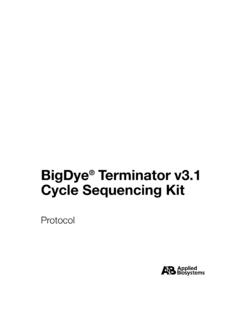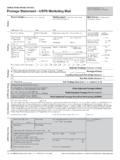Transcription of Selective Precipitation of Proteins UNIT - ibt.lt
1 Selective Precipitation of Proteins Selective Precipitation of Proteins (Rothstein, 1994) can be used as a bulk method to recover the majority of Proteins from a crude lysate, as a Selective method to fractionate a subset of Proteins from a protein solution, or as a very specific method to recover a single protein of interest from a purification step. Except for antibody-mediated precipi- tation (see UNITIO.~), Selective Precipitation methods are usually not protein -specific; the process depends on the physical andlor chemical interaction of the precipitating agent with one or more Proteins that possess certain characteristics. It may be necessary to use a combination of Selective Precipitation techniques to isolate the desired protein . The success of Precipitation is monitored by measuring total protein content (UNITM), by identifying Proteins in the fractions using SDS-PAGE ( unit !)
2 , and by performing a suitable bioassay to identifl the fraction containing the desired protein . Developing a Selective Precipitation technique for a particular protein requires identifi- cation of the appropriate precipitating agent and optimization of the Precipitation proce- dure using that agent. Often, more than one reagent wiI1 successfuIly precipitate a particular protein , so selecting a reagent is a matter of identifying the one that provides the desired protein in the most optimal state. Some reagents cause denaturation or adversely affect bioactivity, and some form complexes that bind the protein tightly. Still others lack the ability to selectively enrich for the desired protein . This unit describes a number of methods suitable for Selective Precipitation (see Table ). In each of the protocols that are outlined, the physical or chemical basis of the Precipitation process, the parameters that can be varied for optimization, and the basic steps for developing an optimized Precipitation are described.
3 Table protein Precipitative Techniques - ~ Technique Protocol - Salting out Isoionic Precipitation Two-carbon (Cz) organic cosolvent Precipitation of Proteins C, and C, organic cosolvent Precipitation , phase partitioning, and extraction of Proteins protein exclusion and crowding agents (neutral polymers) and osmolytes Synthetic and semisynthetic polyelectrolyte Precipitation Metallic and polyphenolic heteropolyanion Precipitation Hydrophobic ion pairing (HIP) entanglement ligands Matrix-stacking-ligand coprecipitation Di- and trivalent metal cation Precipitation Basic Protocol 1, Alternate Protocol 1 Basic Protocol 2, Alternate Protocol 2 Basic Protocol 3 Basic Protocol 4 Basic Protocol 5 Basic Protocol 6 Basic Protocol 7 Basic Protocol 8 Basic Protocol 9 Basic Protocol 10 unit Extraction, Stabilization, and Concentration Contributed by Rex E.
4 Lovrien and Daumantas Matulis Currenl in Frorein Science (1997) Copyriehl fi 1997 hy John Wtley & Som. Inc. Supplement 7 Selective Precipitation of protein protein Precipitation and coprecipitation frequently are quite cooperative (in the equilib- rium sense of the term) like other types of phase , protein precipitations may tend to be all-or-none processes. Therefore good control sometimes can be obtained only within small ranges of conditions, such as in variation of precipitating agents. However, the neighborhood or range of parameters where that can be achieved may best be located by the first, wide-ranging set of experiments. Pilot experiments should make it possible to decide whether the process shall be one of first precipitating out desired Proteins , as opposed to first taking out unwanted Proteins and perhaps other materials and then bringing down desired Proteins in a second stage.
5 Investigation of optimum temperatures is usually useful and even mandatory. Pilot samples may be kept in refrigerators, at room temperature, and at still higher (heat-shock) temperatures, to find the best temperatures for both protecting and precipitating Proteins . protein Precipitation , even when optimized, is sometimes nearly as dependent on rates (kinetics) as on equilibria (thermodynamics). In practice, therefore, attention must be paid to controlling the time of incubation of pilot samples under the various conditions. Strong precipitating agents (synthetic polyelectrolytes are leading examples) may form copre- cipitates within a few seconds, but be irreversible. Intermediate and even quite weaker precipitants may take hours to develop protein coprecipitates but afford more control- lability and reversibility.
6 Choice of Procedure Table lists ten possible techniques for protein Precipitation . Choice of which to use likely depends on how easy or difficult it may be to reverse Precipitation to recover the protein (s) and discard excess precipitating agent. For most use? to which precipitated Proteins are , nutrition, therapy, or simply for assay-the Proteins must be freed of precipitating agents. The quite powerful agents, such as synthetic polyelectrolytes, can be difficult or slow (or both) to remove and release from desired Proteins . Consequently, synthetic polyelectrolyte coprecipitation may best be used for first bringing down un- wanted Proteins ( , where those precipitates are to be discarded). Remaining Proteins in the supernatant may then be captured using a less aggressive but more controllable, reversible precipitating agent from the list in Table ( , Basic Protocols 1 to 5 or S to 10).
7 Removal of Nucleic Acids Clrude Proteins from cell cytosols, especially from bacteria and yeasts, may be laden with iucleic acids (RNA and DNA). Nucleic acids may interfere with protein isolation and :ontribute to haze and colloidal character. It is useful to remove nucleic acids in the early ;tages of crude workup. Techniques for removal of nucleic acids also help remove some cinds of particulates when the particulates have much anionic many :ellular and subcellular membranes. There are two general methods for removing nucleic ~ , Precipitation using polyamines ( ) and using positively charged anion- :xchanger resins (u~ ). Nucleic acids are polyanions that are charged negatively and .ather densely with phosphate groups. Naturally occumng "protamines" (Felix, 1960; 3udavari. 1989). which are Proteins themselves, but very cationic Proteins , thoroughly :oprecipitate most nucleic acids and ribosomes.
8 However, overshooting the endpoint- .e., adding more than enough protamine Proteins to remove the nucleic acids-may leave :xcess protamines in samples, contaminating the sought-for Proteins and perhaps inter- ering with their isolation downstream. Accordingly, it may be necessary to determine the mdpoint for stopping protamine addition using a suitable spectroscopic technique for iucleic acid content (see u~ ). Synthetic polyethyleneimine (PEI; Sigma) and syn- Cumenl )Imlu;olr in Prorein Science thetic polyamino butane compounds (spermine; Sigma) also precipitate nucleic acids, and are useful for large samples (milliliter to liter in volume). A detailed review of PEI (also called Polymin by some vendors) for nucleic acid Precipitation is found in Jendrisak (1987). Between 20 and 80 p1 of 5% PEI, added per ml of crudes containing 4% (dry weight) nucleic acids.
9 Nearly completely removes nucleic acids. This procedure should be carried out at a pH of to 8, where PEI arnine groups are fully cationic and nucleic acids are fully anionic. However, PEI is a very able precipitant for Proteins with isoionic points below pH 7. If the sought-for protein coprecipitates with both PEI and nucleic acids, as some enzymes do, pH variation and salt extraction ( , with NaCI; Jendrisak, 1987) then becomes necessary to free such enzymes from the PEI agglomerate. Anion exchangers may also be used to remove nucleic acids and have an advantage and a disadvantage compared to polyamines used in solution. The advantage is that an excess of solid exchanger may adsorb less of the sought-for Proteins than an excess of such reagents as PEI in solution. The disadvantage is that-because solid resins can only adsorb very large macromolecules like nucleic acids at the resin surface (not in its interior)- rather large quantities of resin may be required.
10 The Amberlite IRA-400 series of resins (Sigma) and Dowex-1 anion exchangers (Sigma) are adsorbants for nucleic acids in neutral pH ranges. The DEAE-celluloses (Sigma), which are quatemized amines and therefore cationic, also are capable of adsorbing nucleic acids to remove them from crudes preliminary to isolating the Proteins from the crudes. See Basic Protocol 2 for directions on washing and conditioning such resins prior to use. Selective Precipitation BY SALTING OUT Ammonium sulfate is the best, first-choice salt for initial development of a salting-out program to precipitate sought-for Proteins (see Fig. ). Other salts may be chosen, and frequently they yield successful results. However because of sulfate's kosmotropic and protein -molecule exclusionary powers (see Commentary), ammonium sulfate is most preferred and best understood.






